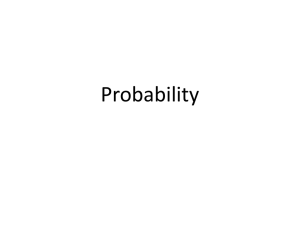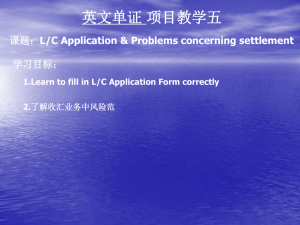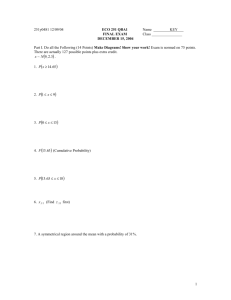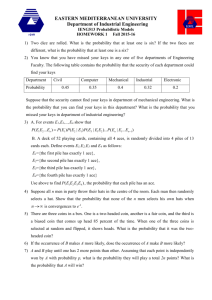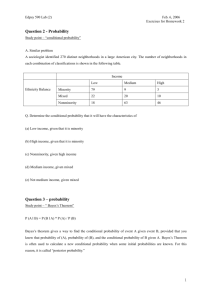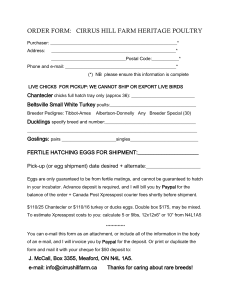Here are the answers: 1. Your firm manufactures computers. You are
advertisement
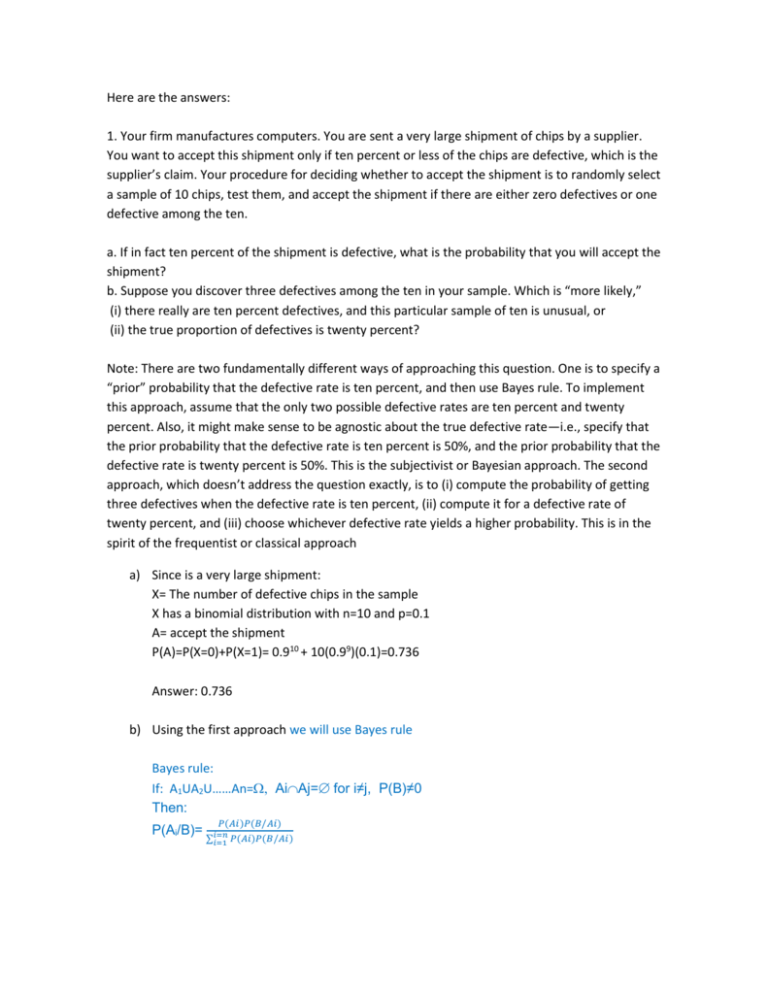
Here are the answers:
1. Your firm manufactures computers. You are sent a very large shipment of chips by a supplier.
You want to accept this shipment only if ten percent or less of the chips are defective, which is the
supplier’s claim. Your procedure for deciding whether to accept the shipment is to randomly select
a sample of 10 chips, test them, and accept the shipment if there are either zero defectives or one
defective among the ten.
a. If in fact ten percent of the shipment is defective, what is the probability that you will accept the
shipment?
b. Suppose you discover three defectives among the ten in your sample. Which is “more likely,”
(i) there really are ten percent defectives, and this particular sample of ten is unusual, or
(ii) the true proportion of defectives is twenty percent?
Note: There are two fundamentally different ways of approaching this question. One is to specify a
“prior” probability that the defective rate is ten percent, and then use Bayes rule. To implement
this approach, assume that the only two possible defective rates are ten percent and twenty
percent. Also, it might make sense to be agnostic about the true defective rate—i.e., specify that
the prior probability that the defective rate is ten percent is 50%, and the prior probability that the
defective rate is twenty percent is 50%. This is the subjectivist or Bayesian approach. The second
approach, which doesn’t address the question exactly, is to (i) compute the probability of getting
three defectives when the defective rate is ten percent, (ii) compute it for a defective rate of
twenty percent, and (iii) choose whichever defective rate yields a higher probability. This is in the
spirit of the frequentist or classical approach
a) Since is a very large shipment:
X= The number of defective chips in the sample
X has a binomial distribution with n=10 and p=0.1
A= accept the shipment
P(A)=P(X=0)+P(X=1)= 0.910 + 10(0.99)(0.1)=0.736
Answer: 0.736
b) Using the first approach we will use Bayes rule
Bayes rule:
If: A1UA2U……An= AiAj= for i≠j, P(B)≠0
Then:
P(Ai/B)=
𝑃(𝐴𝑖)𝑃(𝐵/𝐴𝑖)
∑𝑖=𝑛
𝑖=1 𝑃(𝐴𝑖)𝑃(𝐵/𝐴𝑖)
A1={r=0.1}
A2={r=0.2}
B= {X=3}
We want to compare: P(r=0.1/X=3) and P(r=0.2/X=3)
We know:
P(A1)=P(r=0.1)=0.5
P(A2)=P(r=0.2)=0.5
P(B/A1)=P(X=3/r=0.1)= (10C3)(0.13)(0.97)=0.057
P(B/A2)=P(X=3/r=0.2)= (10C3)(0.23)(0.87)=0.201
𝑃(𝐴1)𝑃(𝐵/𝐴1)
0.5(0.057)
P(r=0.1/X=3)= P(A1/B)= 𝑃(𝐴1)𝑃(𝐵/𝐴1)+𝑃(𝐴2)𝑃(𝐵/𝐴2) = 0.5(0.057)+0.5(0.201) = 0.221
P(r=0.2/X=3)=1-P(r=0.1/X=3)=1-0.221=0.779
Answer: the second option is more likely
the true proportion of defectives is twenty percent
2. (Continued) Suppose the shipment is small in number—say your company receives a
shipment of twenty chips. Your procedure for deciding to accept the shipment is the
same— you randomly select 10 chips, and accept the shipment in this sample you find
either zero or one defective. If the defective rate is ten percent—in other words, if there
are in truth two defective chips in the shipment—what is the probability that you will
accept the shipment?
X = number of defective chips in the sample
X has a hypergeometric distribution N=20, n=10, p=2
P(X=0) = (18C10)/(20C10) = 0.237
P(X=1)= (18C9)(2C1)/(20C10) = 0.526
P(accept the shipment )= 0.237+0.526= 0.763
Answer: 0.763
. Your firm receives an average of 1.3 returns each day for warranty repairs. What is the
probability that on a given day, there will be no returns? Three or more returns?
Let X = number of returns
X has a poisson distribution with =1.3
a) P(no returns )= P(X=0)=0.2725
b) P(3 returns or more)= P(X≥3)=1-P(X≤2)=0.1429
Answers:
a) 0.2725
b) 0.1429
